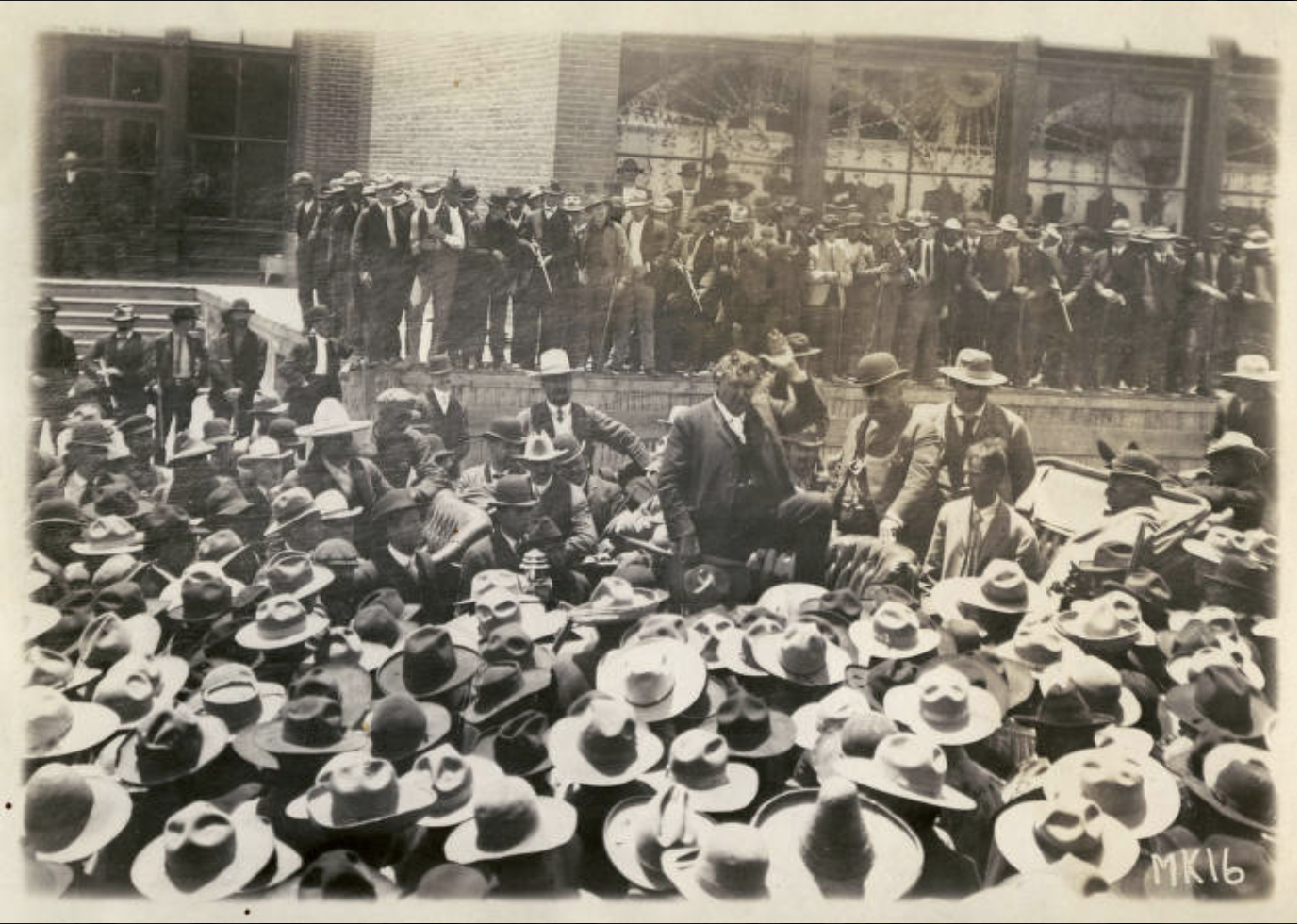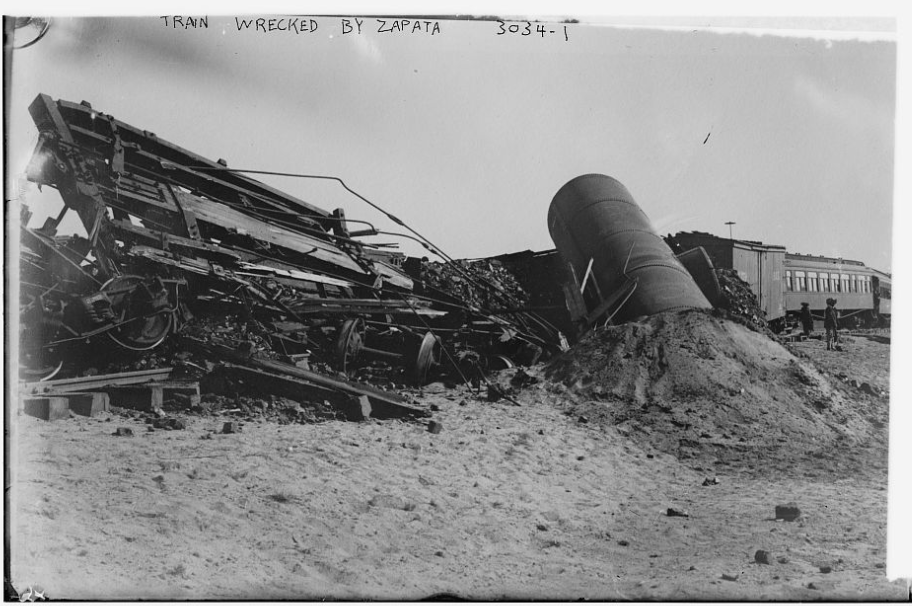Outbreak of Revolution
By the 1900s, unrest among the Mexican populace grew. Poor working conditions led to an increase in the number and sevarity of strikes.
Since 1895 there has been a feeling of unrest in Mexico, which made itself more apparent during the last years of General Diaz's government. This feeling of restlessness was not well defined, and even when it led to several armed movements after 1905 it was generally through that they were only insurrections of a local character.
Above: Luis Cabrera, The Mexican Situation from a Mexican Point of View

Above and below: Great Western View Company. Colonel William C. Greene Addressing Crowd of Mexican Copper Mine Workers Gathered in Front of Police Station during Strike, 1906.

The foreman didn’t touch his pistol now. Then we let him know that we were on the point of quitting, that we had not sold ourselves to anyone. "We’re going now. Get out of here before we cut you to pieces." He left. Then the whole gang said, "Let’s go and leave the tools so we all have a right to our pay." They still owed us for three days. Then everybody said that all they do was take the shirt off our backs. We said, "If they try to do anything to us, we’ll make mincemeat out of them all. Don’t give in!"
Above: Pedro Martinez and Oscar Lewis, in Pedro Martinez. A small rebellion happens at the hacienda Martinez works for.
A new wave of Mexican intellectuals openly criticized the Porfiriato for the suppression of democracy and the impoverished conditions of the poor.
As a result, the entire administrative, judicial, and legislative machinery obey a single will, the caprice of General Porfirio Díaz, who during his long administration has shown that the principal motive that guides him is to maintain himself in power and at any cost.
As a result of such a system of government, profound discontent has been felt throughout the Republic for many years; however General Díaz, with great cunning and perseverance, has succeeded in annihilating all independent elements, so that it was not possible to organize any sort of movement to take from him the power of which he made such bad use.
Above: Francisco I. Madero, "Plan de San Luís Potosí."
The Mexican Revolution started when Francisco Madero, an elite who advocated for and challenged Diaz in the 1910 Mexican elections, rebelled against the Diaz government in the north. It was not initially about land reform: Madero had been fighting to bring his version of democracy to Mexico. With his assassination, the revolution factionalized into disparate groups.
Fellow citizens: If I call upon you to take up arms and bring down the Government of General Díaz, it is not only due to the violations committed during the recent elections, but in order to save the Fatherland from the dark future that awaits it under the continued dictatorship...now that General Díaz intends to rely on brute force to impose upon them this offensive yoke, the people will recur to the same force in order to shake off this yoke, to throw this evil man from power and re-conquer their liberty.
Above: Francisco I. Madero, "Plan de San Luís Potosí."

Above: Train Wrecked by Zapata. 1915

Above: Women Revolutionists [Mexican Revolution; Group of Women and Children Wearing Cartridge Belts and Pointing Rifles]. Sept. 1911.
The revolutionists were fractured by their respective levels of radicalism and allegiances.
Emiliano Zapata, a revolutionary general who drew support from peasants and indigenous groups from the southern and central provinces of Mexico, rebelled against the Madero government. Zapata was famously supportive of land redistribution and radical agrarian reforms.
In virtue of the fact that the immense majority of Mexican pueblos and citizens are owners of no more than the land they walk on, suffering the horrors of poverty without being able to improve their social condition in any way or to dedicate themselves to Industry or Agriculture, because lands, timber, and water are monopolized in a few hands, for this cause there will be expropriated the third part of those monopolies from the powerful proprietors of them, with prior indemnization, in order that the pueblos and citizens of Mexico may obtain ejidos, colonies, and foundations for pueblos, or fields for sowing or laboring, and the Mexicans’ lack of prosperity and well-being may improve in all and for all.
Above: Emiliano Zapata, "Plan de Ayala."
The Constitutionalists, a moderate liberal faction hailing from northern Mexico, were led by Venustiano Carranza. Although some Constitutionalists were sympathetic to calls for land reform, Carranza was heavily supported by the urban middle class and heeded the calls for land reform less.
I disagree. In my own view, the restoration of peace should be brought about by preventive and repres- sive measures, but also by economic reforms that will bring conflicting social groups into a relative state of equilibrium. One of these economic measures that may help to restore peace is the restoration of the ejidos. . . .
Above: Luis Cabrera, "The Restoration of the Ejido." Below: General Villa. 1911.

Allied with Zapata was General Pancho Villa, hailing from the north of Mexico. Similarly to Zapata, he was very sympathetic to the plight of peons and was known for taking land from hacendados and redistributing them to peons in places where he fought.


Above: Zapata and Followers in mural "History of Mexico," holding up banner with slogan "Land and Freedom."
Below: Portrait of Emiliano Zapata.
Allied with Zapata was General Pancho Villa, hailing from the north of Mexico. Similarly to Zapata, he was very sympathetic to the plight of peons and was known for taking land from hacendados and redistributing them to peons in places where he fought.


Above: A snippet of an account of the death of a hacienda owner Villa killed because of the latter's distribution of the former's lands. "Benton Killed by the Rebels' Firing Squad."